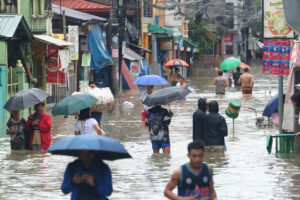
At least 3 die as rivers, dams swell in Philippines due to Tropical Storm Yagi
AT LEAST three people died after Tropical Storm Yagi (Enteng) and the southwest monsoon battered the Philippines late Sunday evening, causing some its rivers to overflow.
Government offices, schools and financial markets were shuttered for the second time in a week as torrential rains flooded Manila, the capital and nearby cities and provinces. More than two dozen local flights to and from the capital were canceled, airport authorities said.
The presidential palace in a statement later in the day also suspended government work and classes at all levels in Metro Manila and the Calabarzon region for Sept. 3.
In an 8 a.m. report, the country’s disaster agency said two people died in Central Visayas, while 10 others were hurt amid heavy rain. Naga City police in the Bicol region in a Facebook post said an eight-month-old baby drowned after several areas of the city struggled with floodwaters on Sunday night.
At least 400 families had been evacuated in Metro Manila’s neighboring provinces such as Cavite, Laguna, Quezon and Rizal on Monday, according to the Department of Social Welfare and Development’s Calabarzon office.
About 1,500 people were staying in 23 evacuation centers in the four provinces, it said, adding that 43 passengers were stranded in the port of Real, Quezon.
A second-level alarm was hoisted over the Marikina River in the capital region as it reached 17 meters. The state weather bureau on Monday warned that La Mesa Dam in Quezon City could overflow and affect low-lying areas in parts of Metro Manila.
The water level at the dam had reached 80 meters as of 1 p.m., just 0.15 meter shy of its spilling level, the state weather bureau said on its website.
It expects the water level to rise further, which would affect low-lying areas along the Tullahan River from Quezon City such as Fairview, Forest Hills Subdivision, Quirino Highway, Santa Quiteria and San Bartolome; Valenzuela City including the North Luzon Expressway and La Huerta Subdivision; and Malabon City.
The center of Yagi, the fifth tropical cyclone to hit the Philippines this year, was over Quirino province after making landfall in Casiguran, Aurora province north of the Philippine capital, the bureau said in a separate 5 p.m. bulletin.
It was packing sustained winds of up to 85 kilometers per hour (kph) and gusts of up to 140 kph, it said, adding that it was moving north-northwestward at 20 kph.
The storm was expected to continue moving northwestward or northward over Cagayan Valley or the northern Cordillera Administrative Region before turning northwestward over the Babuyan Channel by Sept. 3.
OUT BY WEDNESDAY
It was expected to move westward over the South China Sea until Thursday. “On the track forecast, this tropical cyclone may exit the Philippine area of responsibility on Wednesday (Sept. 4) morning or afternoon.”
Yagi was forecast to maintain tropical storm category during its traverse of mainland Northern Luzon. It could become stronger from the afternoon of Sept. 3 onward, and could intensify into a severe tropical storm by Tuesday afternoon or evening.
It could become a typhoon by Thursday.
President Ferdinand R. Marcos, Jr.’s office suspended classes and government work at 8:30 am, but locals said the timing was too late.
The President told reporters he had ordered authorities to ensure that the suspension of classes and work were announced before bedtime “so people can adjust.”
The Philippines lies along the typhoon belt in the Pacific and experiences about 20 storms each year. It also lies in the so-called Pacific Ring of Fire, a belt of volcanoes around the Pacific Ocean where most of the world’s earthquakes strike.
A river in Naga City that winds through 11 villages in the Bicol region’s metropolis reached critical levels as early as Sunday evening, prompting the local government to evacuate residents especially those in low-lying areas.
Water in Ipo dam in Bulacan province north of the capital also rose to near-spilling levels, forcing authorities to release an amount of water that they said would not endanger areas downstream.
Manila Electric Co. (Meralco) said about 28,000 customers had been affected by brownouts, mostly in Metro Manila and Cavite, as well as in parts of Laguna, Rizal, Bulacan, Batangas and Quezon provinces.
“Our crews are working to restore power service to affected areas as soon as possible,” it said in a statement. “We continue to monitor the situation and urge our customers to practice electrical safety.”
Parts of Luzon including Metro Manila were still reeling from the effects of Super Typhoon Gaemi (Carina) and monsoon rains that killed dozens of Filipinos and triggered more than 40 landslides in July.
A World Weather Attribution study on Gaemi and its effects on northern Philippines, Taiwan and China’s Hunan province released last week showed that climate change was enhancing conditions conducive to typhoons.
“When they occur, the resulting rainfall totals and wind speeds are more intense,” it said, noting that tropical cyclones were becoming more intense and wetter.
The study was conducted by 23 researchers including scientists from universities and meteorological agencies in the Philippines, China, Malaysia, the Netherlands, Sweden, United States and United Kingdom.
It showed that Gaemi’s wind speeds were about 14 kph or 7% more intense due to climate change, increasing the rainfall by up to 14%.
“The warm sea surface temperatures that fueled Gaemi would have been virtually impossible without climate change,” it said.
Since 1900, there has been a 30% increase in the number of typhoons as intense as Gaemi that form in the northwest Pacific Ocean, according to the study. — Kyle Aristophere T. Atienza, Sheldeen Joy Talavera and Adrian H. Halili



